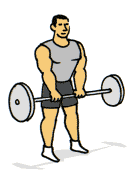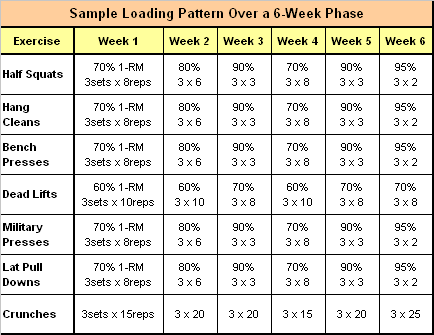This is a sample football strength training program to build maximal strength
Why is maximal strength important?
Quite simply it is a precursor to developing explosive power THE most important physical trait in football. Remember that achieving maximal strength is NOT the end
You must convert any gains in strength into sport-specific power if you want to dramatically improve your performance on the field.
If you need to increase your size and lean weight, you should first follow a hypertrophy program. Its particularly important for linemen. This usually comes before the maximal strength phase
If you havent already, read the Strength Training for Football article.
It covers the big picture how all the different types of football strength training unite into one super-effective program
Maximal Strength Training Guidelines
The following football strength training program is an example only.
You should take advice from a qualified coach or certified strength and conditioning trainer before you attempt any weight lifting routine.
Maximal strength training uses very heavy loads. As such it is not suitable for anyone under the age of 18 and who does not have several years of weight lifting experience. You must have a spotter present at all times.
Back already! Here are the guidelines for maximal strength training:
- Duration of Phase: 3-9 weeks
- Sessions per week: 2-3
- Load: 85% to 100% 1-RM
- No. Exercises: 4-7
- No. Reps per Exercise: 1-4
- No. sets per Exercise: 3-5
- Rest between Sets: 3-5 minutes
- Rest between sessions: 48 hours
Speed of Lifts: As fast as possible with good form
Notice the relatively small number of exercises (3-5). Maximal strength training places a high demand on the central nervous system. Keep training to the bare essentials focusing on the prime movers rather than smaller muscle groups.
Football strength training must be specific to the game. In that sense try to lift weights explosively. You won’t – they’ll be too heavy to move quickly but your efforts will teach your body to recruit the largest number of fast twitch fibres as quickly as possible.
Football Strength Training Program
Half Squat
1. Grasp bar with overhand grip (palms forward) and slightly wider than hip width apart. Step under bar and position bar across posterior deltoids at middle of trapezius (as shown). DO NOT rest bar on neck. Lift elbows up, pull shoulder blades together, and lift chest up to create a shelf for the bar.
2. Start position: Using the legs, remove bar from rack. Stand with feet slighter wider than hip width apart. Back should be straight in a neutral position.
3. Lower body by flexing at the hips and knees. Upper body can flex forward at the hips slightly (~5) during movement. Be sure to sit back so that knees stay over the feet.
4. Once thighs are parallel to floor, return to start position.
5. Remember to keep head and back straight in a neutral position – hyperextension or flexion may cause injury. Keep weight over the middle of foot and heel, not the toes.
6. DO NOT allow knees to go past the big toe or deviate medially or laterally throughout movement. Keep abdominals tight throughout exercise by drawing stomach in toward spine.
Hang cleans (or clean shrugs)
- Keep torso straight but bent forward at the hips slightly.
- Explosively raise the bar by extending the hips, knee and ankle in a jumping action.
- Keep your elbows out and shoulders directly above bar as long as possible. Keep the bar close to the body.
- Once you have extended the lower leg shrug your shoulders and at maximum elevation of the shoulders start pulling with the arms. Keep the elbows high during the pull until the highest point.
- Rotate elbows around and underneath the bar and rack the bar across the front of the shoulders.
- Slightly flex the hips and knees to absorb the weight. This should be a fluid motion where all the steps flow together.

Bench Presses (or jammer press machine)
- Lie on back with head underneath bar, eyes aligned with bar, and feet flat on floor.
- Position hands on bar wider than shoulder width or lower the unloaded bar to chest and position grip to where forearms are perpendicular to the floor.
- Start position: Lift bar off rack with bar directly over head.
- Lower bar to chest at the nipple-line. Press bar up to starting position.
Dead Lifts
- Start Position: Assume a shoulder width stance, knees inside arms and feet flat on floor.
- Position shoulders slightly over bar and grab bar. Begin pull by extending the knees.
- Keep angle of your back constant and lift bar straight up. Keep bar close to the body and keep shoulders directly over the bar.
- Return to starting position.

Military Presses
- Sit in upright position or stand with feet shoulder width apart and knees slightly bent.
- Start position: Position barbell to ear level with an overhand grip (palms facing forward).
- Press hands up above head keeping wrists over the elbows and arms moving parallel to body at all times. Return to start position.
- Remember to keep back and head straight in a neutral position – hyperextension or excessive flexion may cause injury.

Lat Pull Downs
- Adjust seat or knee pad height so that knees are secured while seated.
- Grasp bar with a overhand grip wider than shoulder width apart and sit with knees secured in pads.
- Start position: Fully extend arms with elbows facing out with back straight (you may lean back at hips approximately 5-10).
- Pull bar down to upper chest area and squeeze shoulder blades together at end of movement. Return to start position.
- Remember to keep torso stationary throughout movement.
Crunches
- Start position: Lie back onto floor or bench with knees bent and hands behind head. Keep elbows back and out of sight. Head should be in a neutral position with a space between chin and chest.
- Leading with the chin and chest towards the ceiling, contract the abdominal and raise shoulders off floor or bench.
- Return to start position.
- Remember to keep head and back in a neutral position. Hyperextension or flexion of either may cause injury.
- If adding resistance hold a weights plate with folded arms across chest.

The chart is an example of how loads might vary of the course of a 6-week phase. Deadlifts have a lighter resistance as too much weight can place strain on the lower back.
Don’t forget, this is just one phase of a football strength training program. Check the other articles for programs that fit into other phases.
And make sure to read the 12-month football strength training article which plugs everything into a complete plan.

Jacky has a degree in Sports Science and is a Certified Sports and Conditioning Coach. He has also worked with clients around the world as a personal trainer.
He has been fortunate enough to work with a wide range of people from very different ends of the fitness spectrum. Through promoting positive health changes with diet and exercise, he has helped patients recover from aging-related and other otherwise debilitating diseases.
He spends most of his time these days writing fitness-related content of some form or another. He still likes to work with people on a one-to-one basis – he just doesn’t get up at 5am to see clients anymore.